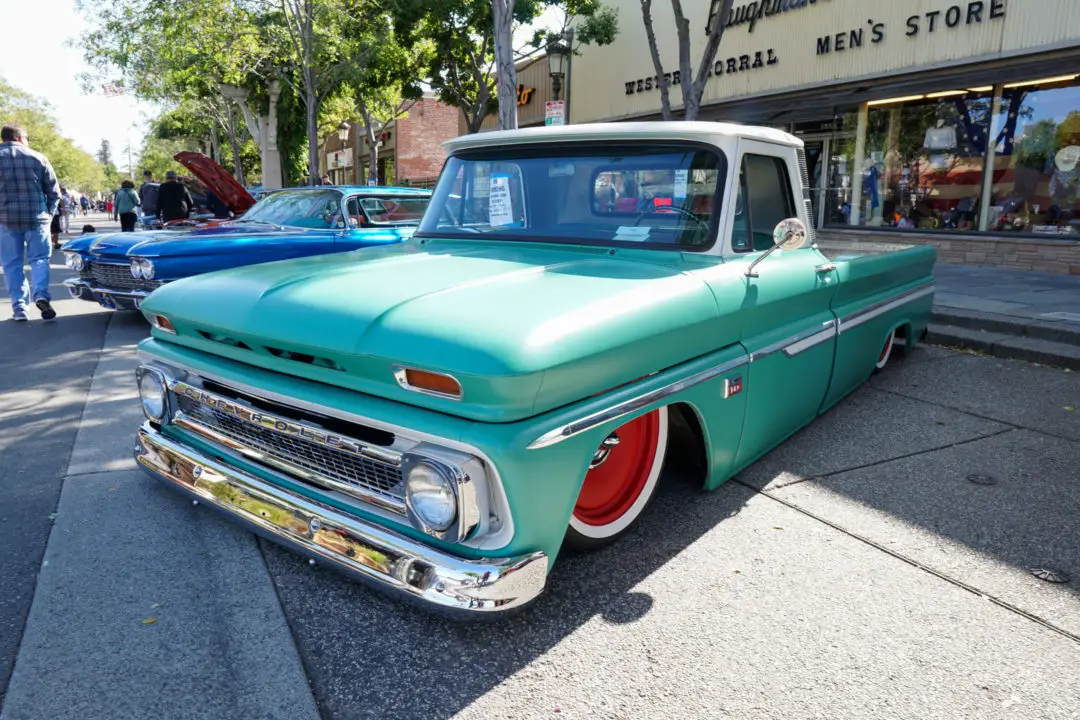The term “C10” has evolved as classic truck slang, used when mentioning any classic Chevrolet truck. When someone says, “Hey I saw a bunch of C10’s rolling down the freeway”, they are generally saying a group of Chevy trucks. However, a true Chevy C10 only carries over a few decades and three generations of trucks.
What is a Chevy C10 Truck?
The C10 model was used by Chevrolet in the years 1960-1987 to define the 2WD drivetrain and ½ ton chassis of every truck they produced. The “C” marking the truck as 2-wheel drive, and the “10” marking it as a half-ton. Chevy C10, or Chevrolet 2wd, ½ ton pickup.
Want to see a C10 Truck Show in your are? I’ve written an article listing all the major C10 shows around the country.
What are the Chevy C10 Truck Years?
The Chevy truck received the C10 badging for the first time in 1960. Chevrolet continued with C10 to define a model of their truck through three decades, across three body styles, until its final year in 1987. The three distinct generations of truck years for the C10 are:
- 1960-1966
- 1967-1972
- 1973-1987
With every generation of this truck came changes that are unique to the exterior and interior features.
I have created an outline to help you spot a Chevy C10 truck and know what year it was produced.
First Generation C10: 1960-1966
Ignition keys are dash mounted by radio: The quickest way to identify a C10 Chevy truck is to locate where you insert the ignition keys. In the 1960-1966 generation the key tumbler is mounted in the gauge cluster just above and to the right of the steering column.
Parking lights are in the hood: Chevrolet created two pods on either side of the front hood to place the trucks parking and marker lights. This is very distinct from all classic trucks you may see at a car show.
2 Tailgate latches: The rear tailgate has a real farm truck look with a chain that dangles on both sides. The tailgate has a folding latch that when closed, folds over to the bed side. A pin or latch connected on the chain is slid then through.
Headlights protruding from grill: The headlights are in a grill insert with a convex bezel that is used for mounting. This grill changes through the years but they all resemble a bezel that is “floating”.
Body line is indented: The side body line has a smooth curve at the top and a sharp inward curve that ran the length of the truck side. It is a prominent feature that flows to connect the hood, cab, and the side of the bed.
Second Generation C10: 1967-1972
Ignition keys are dash mounted by radio: You can determine a C10 to be a 1967-1972 when you look inside the cab and locate the key ignition
Parking lights in the grill: The 1967-1970 years have the parking lights located in grill next to the headlight. From 1971-1972 the parking lights are moved lower and mounted in the front bumper.
Headlights become recessed: The headlight bezel, grill, and molding become one piece. The headlights are slightly pushed back and the bezel surrounding them is slightly concave.
Body receives front and rear side markers: When you look at a C10 from the side, a 1967-1972 will have illuminating parking lights in the front and back of the body panels.
K5 Blazer is introduced: The first year for the Chevy Blazer was 1969. Chevrolet felt the need to enter the sport utility market in response to the Ford Bronco and Jeep Cherokee.
Third Generation C10: 1973-1987
Front hood has square corners: What is a Squarebody? The term “Squarebody” is a nickname given to Chevy trucks that were manufactured from 1973-1987. The word refers to the very straight, horizonal hood line that ends and “squares” off at the corners. All 2WD/4WD trucks, blazers, and suburban’s can be referred to as a Squarebody.
Rear brake light wraps around corner: The rear taillights of a Squarebody are mounted on the rear of the bed, like the earlier years. What is different, is the rear brake light and the side markers are built into one bezel that wraps around the corner of the bed side.
Side body line is flatter: The body lines are a very subtle change from the 1967-1972. Part of the Squarebody nickname is how flat and square the body lines of the side have become.
Ignition keys are on the steering column: In 1973 Chevrolet moved the ignition tumbler from the dash onto the steering column. The placement of the key onto the steering column has been the standard for all manufacturers now for many decades.
What is the Most Popular C10 Year?
The 1972 Chevy 2-wheel drive, short bed C10 is the pickup most muscle truck and hot rod builders are searching for to rebuild or modify. In my opinion it is because it is the best optioned, best designed, chassis and body that is still relatable to the early years of hot rodding your pickup truck.
After 1972, the body style changed and continued with little changes up until the late 1980’s. The later years of the 1970’s brought in the era of smog equipment of every car and truck. So, the appeal raw appeal of a true muscle truck peaked in 1972. Right before the C10 was forced to reduce horsepower to meet smog regulations. The 1972 rear suspension coil springs were replaced with heavier duty leaf springs that made the truck ride stiffer down the road.
Chevy Made Heavy Duty C20 and C30 Trucks
Chevrolet also produced the 2-wheel drive truck in ¾ and 1-ton chassis options. Those trucks were marked with a C20 badge for ¾ ton, and C30 badge for 1-ton. The increased tonnage on the C20 and C30 truck chassis allows for more payload in the frame and rear suspension for heavier carrying capacity and towing.
Can C10 be a 4×4?
A chevy C10 did not come as a 4×4 from the factory because the “C” in the model type signifies 2-wheel drive. Chevrolet did manufacture 4-wheel drive trucks during the 1960-1987 era and tagged them by replacing the “C” with a “K”. Like the drivetrain and chassis outlined above, Chevy made K10, K20, and K30 models. These badges would represent their four-wheel drive(K) ½ ton, ¾ ton, and 1-ton trucks.
What C10 and K10 trucks do have in common is all the exterior body panels and interior options. For example, a front fender from a 4wd and 2wd chevy truck of the same year are the same. The interior dash layout, gauges, seats, and steering wheel are all the same. All but one difference in the interior of the C10 and K10 trucks. The four-wheel drive trucks have an additional shifter on the center floor for manual shifting into 4WD. Having this shifter does require a different transmission bulge or hump going down the middle of the interior floorboard. This is there to make room for the transfer case in the drivetrain that controls the truck in 2WD or 4WD.
What Chevy Trucks are NOT a C10?
The “C10” badge has a long run being proudly mounted on the front fenders of Chevy trucks for nearly three decades. That is an amazing run, and the main reason C10’s has had such a strong following.
The C10 slang for Chevy trucks evolved to “CK” when describing the 1988 up to 1998 models. Silverado became the term to describe the Chevrolet pickups in 1999.
What does CK mean? The term CK is used to describe two-wheel drive and four-wheel drive Chevy trucks from 1988-1998. During this time, the ½ ton, ¾ ton, and 1-ton models found their respective 1500, 2500, and 3500 decals on the lower side molding near the front door.
Can a Silverado be a C10? The term Silverado is used to represent Chevy two-wheel drive, ½ ton trucks manufactured from 1999-current but it is
not considered a C10. The Silverado is the current model for chevy pickups after C10 and CK generations.
The later years of the 1980’s to 1990’s saw the Chevy truck era for CK Chevy truck and the Silverado.


